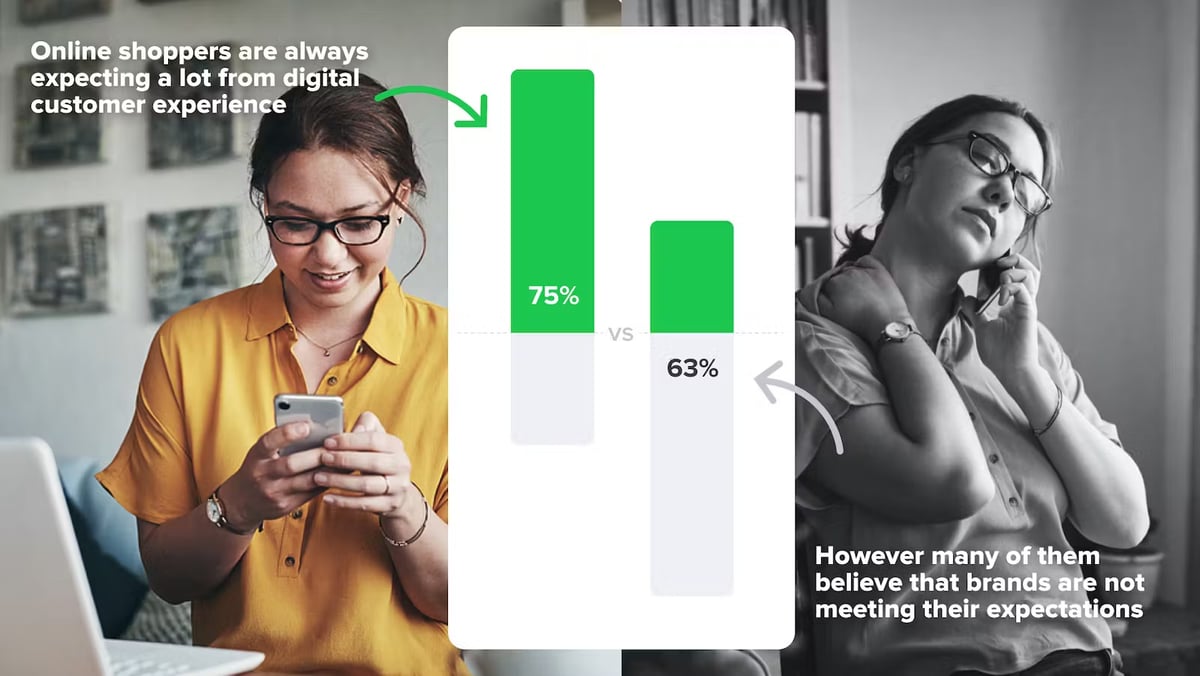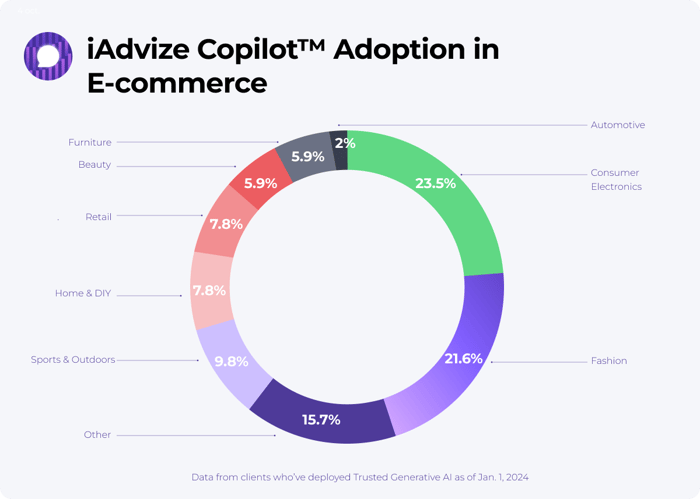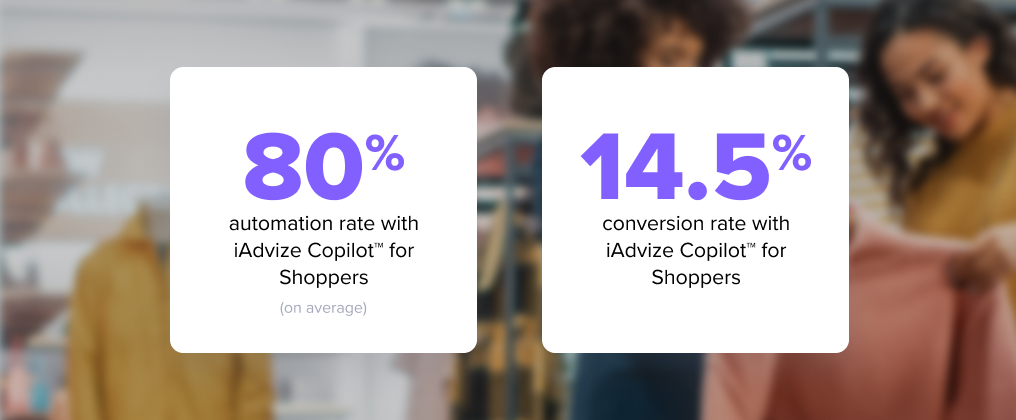Conversational Commerce in Fashion: Reinventing the Online Retail CX
Julia Lackey

After experiencing years of exponential growth around the pandemic, with increases reaching up to 30% in the United States and Europe in 2020, e-commerce has now stabilized at a steady rate. Forrester projects annual increases of 10% in the United States and 11% in Europe through to 2025, figures that harken back to those seen before the health crisis.
Within the realm of online sales, fashion continues to dominate; Statista reported that in 2023, fashion and accessories made up 21% of all e-commerce businesses. The sector's significant presence on digital platforms is largely due to its rapid adoption of digital transformation opportunities like generative AI for e-commerce, influencer marketing, and adapting to changing consumer expectations for products and values. However, the main challenge that remains to shape the future of fashion retail lies in redefining the customer journey.
In this article, we’ll dive into:
- The new customer experience in fashion
E-commerce is essential: Forrester found that 36% of all global fashion retail sales are made online. However, 75% of consumers have high expectations for their online shopping experiences, but only 63% believe that brands meet them.
- Consumer engagement opportunities through messaging
To bridge this gap, brands are adopting a conversational commerce strategy, which enables them to offer more tailored and personalized interactions with their website visitors.
- Generative AI as the key to e-commerce success
Fashion brands and retailers account for 21% of all generative AI deployments on the iAdvize conversational commerce platform.
The New Customer Journey in Fashion E-Retail
Growth Opportunities in Online Sales
"One of the biggest challenges facing fashion today is meeting the rising demands of digitally native customers at each point in the customer journey. Customers expect you to know what they want and deliver personalized experiences tailored to them."
Fashion Retail CX: Closing the Experience Gap in Fashion, by The Future of Customer Engagement and Relations
The impact of the e-commerce revolution is particularly evident in the fashion sector. In 2022, online transactions accounted for 36% of total fashion retail sales, a significant increase from 27% in 2018. This penetration of online fashion sales is roughly double that of total retail sales, where e-commerce represented 27% of total fashion sales compared to 15% across all retail sectors in 2018. And these numbers continue to go up year over year.
For consumers, the shift to digital is irreversible, aligning with their increasingly mobile and technology-driven lifestyles. However, a noticeable disparity exists between their expectations for online shopping and the actual experience provided by brands. While 75% of consumers have high expectations for their online shopping experiences, only 63% feel that brands successfully meet them.

The Gap Between Customer Expectations & the Reality of Online Shopping Experiences
Hyper-Personalization as the Solution: Highly Targeted Responses
One of the major challenges for many brands in the fashion industry in the coming years will be to offer an extremely personalized and scalable customer experience. Today's consumers seek tailored interactions at every step of their buying journey, and expect businesses to understand their specific preferences and requests.
McKinsey notes that 71% of consumers expect companies to offer personalized interactions, and 76% get frustrated when this doesn’t happen. Personalization has become imperative for companies wishing to remain competitive in the online space.
Digital & Physical Shopping Experiences Go Hand-In-Hand
Although more and more consumers buy clothes and accessories online, physical stores aren’t obsolete. The customer journey is no longer linear, and people have become accustomed to shopping both online and in-store, before following through with a purchase.
This trend of seeking out hybrid shopping experiences is pushing brands with physical touchpoints to rethink their goals. In a Forrester study, 40% of connected consumers say they enjoy shopping in stores much less today than before the pandemic. And yet, another 40% say they don’t rule out purchasing from a store. Why the discrepancy? Shoppers tend to begin their buying journey online, but turn to physical stores when they encounter a frustrating or difficult e-commerce user experience.
Digital Engagement Through Improved Customer Interactions
To limit frustration during the online purchasing experience, Fashion & accessories businesses are investing in conversational commerce technologies.
Retail That Listens to its Customers
Messaging is a channel that has become integral to our daily lives, and is now a critical channel in the fashion sector. This fluid and personalized mode of communication has put the customer at the center of the brand relationship, compared to more traditional and frustrating channels like phone and email.
Beyond improving the customer experience, the goals of a conversational commerce strategy with messaging for brands and retailers should be:
- Increasing Direct-to-Consumer (D2C) Sales
Due in part to the value of collecting customer data, it’s important that companies have a mechanism for selling directly to consumers, either online through an e-commerce website, or through their own brick-and-mortar stores.
- Developing a Web-to-Store Strategy
In 2022, store openings in the United States exceeded closures for the first time in over three years. To better optimize their business strategy, retailers should focus more on building a seamless and reliable ‘phygital’ shopping experience, with online touchpoints in line with their brand image and complementary to their in-store experience. Because they help establish trust, online conversations with brands foster customer loyalty and continued relationships.
The Role of Conversations in Managing Clothing Returns
Due to changes in how consumers interact with brands and make purchasing decisions leading to an increased volume of returned products, a top challenge for fashion brands has become returns. The growth of online sales channels and the practice of free returns have shifted customers’ approaches to purchasing, where orders are now considered more of a risk-free product discovery process than as a final step. McKinsey notes that this phenomenon is particularly noticeable in the product categories of women's shoes and dresses.
For businesses, this heightened volume of returns—24.4% of fashion purchases were returned in 2023—comes at a cost. Brands lose money on shipping and return costs, and overall revenue decreases. Moreover, if this return experience is deemed disappointing by the consumer, there’s a high chance that the brand will permanently lose them as a customer.
Despite this, the problem is still relatively unaddressed by the fashion sector. McKinsey cites four main obstacles preventing companies from successfully solving the issue of returns:
- Customer experience-focused retailers feel obligated to accept high levels of returns
- Achieving efficiency in reversing the order process is difficult
- It’s difficult to pinpoint one necessary solution, given the cross-functional nature of returns
- There’s a lack of data that limits companies' ability to understand and address root causes
Therefore, retailers' ability to be immediately available 24/7 and respond in a personalized way to all users seems essential to solving the problems that cause them to return purchases. More so than in-store, advice and recommendations through online chat and messaging is fundamental to helping guide shoppers towards their decision to buy confidently.
Yet, online shoppers are the customers that are most often left to self-service. New customer service technologies are changing this, in order to remove final barriers to purchase and accompany them at all points throughout their buying journey.
Companies in the fashion and accessories sector that engage in conversation with their customers across a wide range of channels are at the forefront of customer experience. In the competitive quest for creating a "wow" effect and fostering loyalty, innovation becomes a necessity.
Strategies to Improve the Fashion Customer Journey
In 2023, generative AI made a significant impact on e-commerce, emerging as a key tool for crafting better online conversational experiences. The fashion industry, always at the cutting edge of e-commerce trends, quickly embraced this technology, establishing itself as a leader.
Today, out of more than 100 deployments, fashion represents 21.6% of the total brands that have integrated generative AI into their conversational strategy.

The Benefits of Using Generative AI in Fashion E-commerce
According to a study conducted with Ipsos, 50% of American people abandon purchases due to unclear or missing product information. For clothing items, this is typically related to questions about sizing, fit, or style.
There’s a real need for better support in the online shopping journey. Agents can’t be available at all hours of the day and are limited in the volume of conversations they can handle at one time.
Knowing that, how can companies scale conversational commerce? The best solution is automation coupled with advanced generative AI. Deployment is simple, and 74% of consumers want it to help them get detailed information on the products they’re interested in.
“When you know that 50% of people abandon an online purchase because they can’t find information about a product, you realize the importance of providing a quick response regardless of the time of day, the moment in the day, or the number of people seeking information.”
Aurélie Labatut-Leroux, E-commerce & Omnichannel Director at IKKS
Innovations in Customer Engagement
In the apparel industry, providing customer advice is crucial. Generative AI has revolutionized this aspect by enabling the creation of conversational experiences in natural language. With new software like iAdvize Copilot™, customers gain access to a virtual shopping assistant that’s available 24/7 to answer questions.
Bots like these are connected to data sources companies choose to share with them—such as product catalogs, FAQs, and knowledge libraries—to give them total control over the artificial intelligence’s responses. Once implemented, the AI tool acts as an expert on all things fashion, answering customer inquiries about the products, delivery costs, return policies, and more on an e-commerce website.
Beyond this, the appeal of using a generative AI chatbot lies in its user-friendliness. Shoppers can engage with an iAdvize Copilot™ shopping assistant just as they would with a human customer service agent. These AI solutions built for e-commerce effortlessly provide accurate and reliable product information to all your site visitors, while eliminating the need for extensive training.
Product Discovery With the Help of Conversational Artificial Intelligence
Virtual AI assistants are particularly adept at offering product recommendations and shopping advice. Generative AI can precisely understand a customer's needs and preferences, and with just a few questions, shoppers are given a selection of options tailored to their criteria.
Since introducing generative AI, there has been a notable increase in the proportion of conversations that are either fully or partially automated. On average, 80% of conversations in the fashion industry are fully automated using iAdvize Copilot™ for Shoppers. Its ability to manage large volumes of conversations while maintaining high quality interactions makes it an indispensable tool, especially during peak activity periods.
Augment Your E-commerce Promotional Tactics with AI
During Black Friday 2023, we observed a 52% boost in conversations and 163% increase in transactions on our conversational commerce platform. To better cope with peaks in traffic during online promotions, it's important for companies to scale their conversational customer experience strategy.
You can get started doing this with the following steps:
- Integrate iAdvize Copilot™ for Shoppers to offer reliable, personalized responses to your site visitors via ecommerce chatbot.
- Integrate iAdvize Copilot™ for Agents to give you agents better response support through AI suggestions, corrections, and syntax and spelling help.
Case Study: IKKS Adopts Generative Artificial Intelligence to Support 52% More E-commerce Site Visitors
IKKS embraced messaging in 2017 to enhance customer support on its website, offering personalized advice and recommendations akin to the in-store shopping experience. By September 2023, due to the increasing volume of site visitor requests and the need to manage costs more effectively, the business sought to find an innovative solution for automating its messaging strategy.
That’s when IKKS turned to ecommerce AI in the form of Trusted Generative AI copilots, confident in the technology’s ability to deliver quality interactions that surpass those provided by older generation chatbots (NLU).
"For us, it’s a technology that optimizes the customer experience on our site while ensuring cost control, regardless of the volume of conversations handled. Considering that the conversion rate of a visitor who engages in a conversation is higher than that of a visitor who doesn’t interact with the bot, it ultimately leads to more conversions and revenue on our site."
Aurélie Labatut-Leroux, E-commerce & Omnichannel Director at IKKS
On average, iAdvize customers in the fashion sector achieve:

How Conversational Commerce is Shaping the Future of Fashion
The fashion industry is navigating a complex landscape of challenges and opportunities as it seeks to revolutionize CX. With the growth of online commerce and the evolving expectations of site users, brands are compelled to adapt by providing personalized and transparent experiences that promote convenience throughout the buyer journey.
The implementation of conversational strategies, including the use of ecommerce AI, is proving to be an effective tactic in meeting these challenges. Businesses like IKKS are leading the way by automating a significant portion of their customer interactions with AI solutions for ecommerce. This move has enabled them to offer more efficient support, enhancing users’ navigation capacity, and leading to notable increases in sales and retention.
In an increasingly competitive landscape, companies that invest in innovation and place the customer at the heart of their strategy will be the ones that succeed in the fashion industry going forward.





.png)



